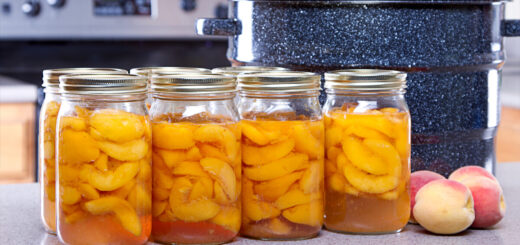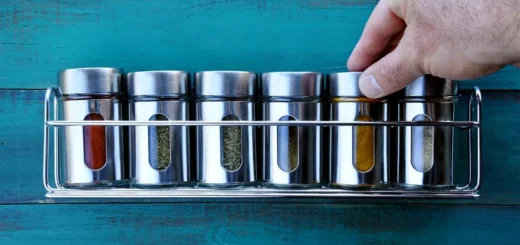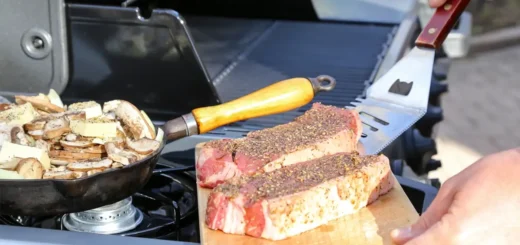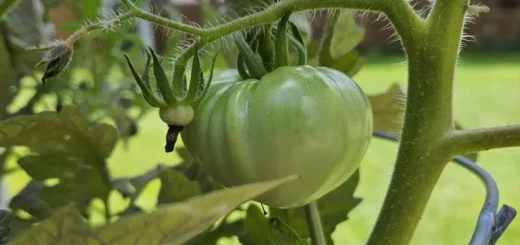10 Ingenious Ways to Prepare Food Without Power
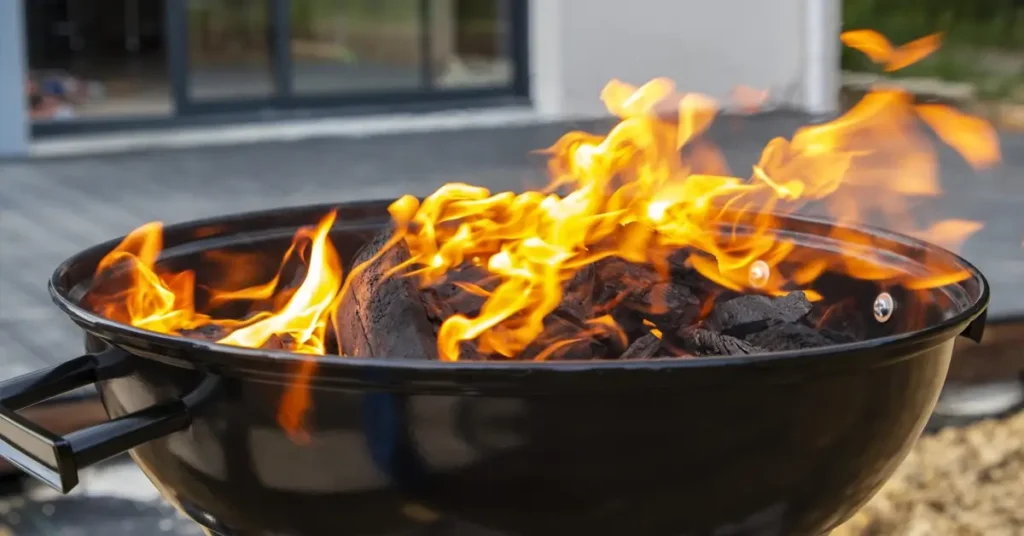
Hey there! Have you ever found yourself in a situation where a power outage left you with no way to cook your meals? It can be frustrating and even stressful when the electricity goes out. In this Southern Prepper article, we’ll explore ten ingenious ways to prepare food without power.
Whether you’re camping, experiencing a natural disaster, or simply want to be prepared for unexpected situations, these techniques will come in handy.
When the lights go out, it’s great to have alternative cooking methods up your sleeve. Not only will this knowledge give you a sense of self-sufficiency, but it can also be a fun and adventurous experience for you and your family.
So, let’s dive into the world of non-electric cooking methods and discover the possibilities.
Table of Contents
Exploring Non-Electric Cooking Methods
When it comes to preparing meals without electricity, exploring non-electric cooking methods opens up a world of possibilities.
From cooking on open fires to using grills and harnessing the power of the sun with solar cooking, these techniques offer practical and inventive ways to cook delicious food.
Whether you’re camping in the great outdoors, experiencing a power outage, or simply seeking sustainable cooking options, these non-electric methods have stood the test of time.
1. Cooking On Open Fires
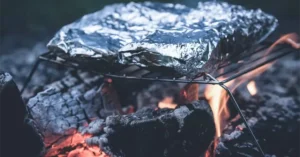
During a power outage, one classic approach is relying on the good old-fashioned open fire or campfire cooking. It’s a time-tested technique that our ancestors used for centuries, and it still works like a charm.
Gathering around the crackling flames, you can roast marshmallows, cook hot dogs, or even prepare a hearty stew in a cast-iron pot suspended over the fire.
Open Fire Cooking Techniques
- Skewers and Roasting Sticks: Use long skewers or roasting sticks to cook foods like sausages, marshmallows, or kebabs directly over the flames. Rotate the skewers to ensure even cooking.
- Grilling Grates: Place a grill grate over the fire to create a cooking surface. This allows you to grill meats, vegetables, or even toast bread.
- Dutch Oven Cooking: Dutch ovens are heavy, cast-iron pots with sturdy lids. They can be placed directly in the fire, allowing you to bake, roast, or stew various dishes. Place hot coals on top of the lid for even heat distribution.
- Cooking on Flat Stones: Flat stones placed near the fire can serve as a cooking surface for items like flatbreads or pancakes. Ensure the stones are clean and free of any moisture to prevent cracking.
Temperature Control
- Adjust the heat intensity by adding or removing wood from the fire. More wood creates higher flames and heat, while reducing the wood decreases the heat.
- Move your cooking utensils and pots closer or further away from the flames to control the cooking temperature.
- If needed, use aluminum foil or makeshift wind barriers to protect your food from direct flames and wind.
Fire Safety and Extinguishing
- Once you’ve finished cooking, allow the firewood to burn completely to ash, ensuring there are no remaining embers or hot coals.
- Use water or sand to fully extinguish the fire. Pour water or spread sand over the fire pit, stirring the ashes to ensure everything is cool to the touch.
2. Cooking With A Grill
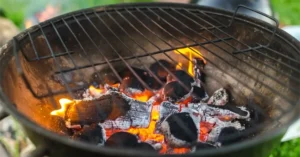
If you don’t have access to an open fire or prefer a more controlled cooking environment, consider using a charcoal or propane grill.
Grilling is a versatile outdoor cooking method that can be adapted for emergency situations. Whether you have a charcoal or gas grill, both options can provide you with a reliable cooking surface during power outages or emergency scenarios.
Charcoal Grill
- Charcoal grills are a popular choice for outdoor cooking and can be used during emergencies when electricity is unavailable.
- To use a charcoal grill, you’ll need charcoal briquettes, a lighter or matches, and a grill grate.
- Start by arranging the charcoal briquettes in a pyramid shape in the center of the grill.
- Use lighter fluid or newspaper to ignite the charcoal. Allow the briquettes to burn until they are covered with gray ash, indicating they are ready for cooking.
- Once the charcoal is ready, you can place your food on the grill grate and adjust the temperature by positioning the grill’s vents.
- Monitor the cooking process closely and turn the food as needed to ensure even cooking.
Gas Grill
- Gas grills are another excellent option for emergency cooking, especially if you have a propane or natural gas supply.
- Ensure that your gas grill is in good working condition and that you have a sufficient gas supply.
- Follow the manufacturer’s instructions for safely igniting and operating your specific gas grill model.
- Preheat the grill by turning on the burners and allowing them to heat up for a few minutes.
- Place your food on the grill grates, close the lid, and adjust the temperature using the grill’s control knobs.
- Keep an eye on the cooking process to prevent any flare-ups or overcooking.
By using a grill during an emergency, you can enjoy a range of cooking options, from grilling meats and vegetables to even baking pizzas or bread on the grill.
Keep all your necessary supplies, such as charcoal or gas, on hand and practice safe cooking to make the most out of this popular non-electric cooking method.
3. Cooking With Solar Power
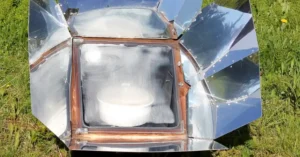
Another brilliant alternative is solar cooking. Harnessing the power of the sun, you can use solar ovens to cook your meals without any electricity.
Solar cookers or solar ovens are designed to trap and retain solar energy, allowing you to bake, roast, or slow-cook your favorite dishes.
These cookers are constructed with reflective materials, such as mirrors or shiny surfaces, to concentrate sunlight onto a cooking chamber or pot. The concentrated sunlight converts into heat energy, which then cooks the food.
Types of Solar Cookers:
- Box Cooker: This type of solar cooker consists of an insulated box with a transparent lid and reflective panels on the sides. It creates a greenhouse effect, trapping the solar heat inside the box for cooking.
- Parabolic Cooker: Parabolic cookers use a curved reflective surface to concentrate sunlight onto a focal point, where the cooking vessel is placed. They can achieve higher temperatures and cook food faster than box cookers.
- Panel Cooker: Panel cookers consist of reflective panels that focus sunlight onto a cooking pot or tray. They are lightweight and portable, making them ideal for outdoor use.
Cooking with a Solar Cooker
- To cook with a solar cooker, you need a sunny day with clear skies for optimum performance.
- Set up the solar cooker in an open area where it will receive direct sunlight without obstructions.
- Place the food you want to cook inside the cooking vessel or pot.
- Position the pot in the cooking chamber of the solar cooker, ensuring that it is centered and in contact with the focused sunlight.
- Adjust the position of the cooker or its reflective panels throughout the cooking process to track the sun’s movement and maintain optimal heat concentration.
- Solar cooking generally takes longer than traditional cooking methods, so patience is key. Cooking times can vary depending on factors such as sunlight intensity, outside temperature, and the type of food being cooked.
- It’s important to monitor the food for doneness and ensure that it reaches safe cooking temperatures to prevent any foodborne illnesses.
Solar cooking is an excellent option for outdoor activities like camping, picnics, or in emergency situations when electricity is unavailable. It offers a sustainable and energy-efficient alternative to conventional cooking methods.
Position your solar oven to maximize sun exposure and be patient with the longer cooking times. Solar cooking is an eco-friendly and efficient method that can be surprisingly effective, especially in sunny climates.
4. Cooking With Propane or Gas Stoves
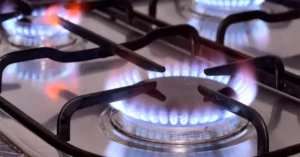
In some cases, you might have access to a gas-powered stove right in your kitchen during a power outage. If that’s the case, lucky you!
Propane or gas stoves are reliable and convenient cooking options, especially during emergencies or situations where electricity is unavailable. These stoves operate independently of the power grid, providing a dependable heat source for cooking meals.
Fuel Sources
Make sure you have a sufficient supply of fuel and follow the manufacturer’s instructions for safe usage.
- Propane Stoves: Propane is a commonly used fuel for portable stoves. It is stored in pressurized cylinders that can be easily attached to the stove. Propane cylinders come in various sizes, allowing for flexibility in terms of portability and cooking duration.
- Natural Gas Stoves: Natural gas stoves are typically connected to a natural gas supply line in residential or commercial settings. They offer the advantage of a continuous fuel source without the need for manual refills or cylinder replacements.
Propane or gas stoves provide a reliable and efficient cooking method during emergencies or when electricity is unavailable. They offer precise temperature control, making them suitable for a wide range of cooking techniques. However, it’s important to prioritize safety and proper usage to ensure a smooth cooking experience.
If you smell gas or suspect a gas leak, immediately turn off your stove and ventilate the area. Seek professional assistance as soon as possible.
5. Cooking With A Dutch Oven
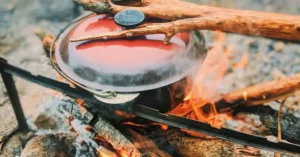
Cooking with a Dutch oven when you have no electricity allows you to enjoy delicious meals with the convenience of a versatile and portable cooking vessel.
Their durability and ability to withstand high heat make them an excellent choice for outdoor cooking, camping, or emergency situations.
With a little practice and experimentation, you can master the art of Dutch oven cooking and savor flavorful meals even without access to electricity.
Dutch Oven Basics:
Dutch ovens are heavy, thick-walled pots made of cast iron or other durable materials. They come with a tight-fitting lid, which helps trap heat and moisture, making them ideal for slow-cooking methods.
You can use a Dutch oven on many different heat sources such as an open fire, charcoal briquettes, or a camp stove. The even heat distribution of the cast iron allows for consistent and efficient cooking.
Preparing the Dutch Oven:
Before cooking, it’s essential to season your Dutch oven if it’s not already seasoned. Seasoning involves coating the pot with a layer of oil and heating it to create a non-stick surface.
To season a Dutch oven, clean it thoroughly, then apply a thin layer of vegetable oil or shortening to all surfaces, including the lid. Place it upside down in an oven preheated to around 350°F (175°C) for about an hour. Let it cool and wipe off any excess oil.
Dutch Oven Cooking Methods:
Dutch ovens are incredibly versatile and can be used for various cooking techniques, including baking, roasting, simmering, and even frying.
Baking: Place your prepared dough or batter in the Dutch oven, cover it with the lid, and position it over the heat source. You can regulate the temperature by adjusting the amount of heat underneath and on top of the oven.
Roasting: Use the Dutch oven with the lid on to roast meats, poultry, or vegetables. The enclosed environment helps retain moisture and enhances flavor.
Simmering and Stewing: Prepare hearty stews, soups, or braised dishes by simmering ingredients in the Dutch oven over low heat. The thick walls and tight-fitting lid allow for slow and even cooking.
Frying: Dutch ovens can be used for shallow or deep frying. The depth of the pot helps contain the oil, while the even heat distribution ensures consistent frying results.
Heat Control: When using a Dutch oven without electricity, controlling the heat is crucial. For open-fire cooking, adjust the distance of the Dutch oven from the flames to regulate the temperature. When using charcoal briquettes, use a charcoal chimney starter to light and prepare the briquettes. Place a specific number of briquettes on top and underneath the Dutch oven, depending on your desired temperature (a general rule of thumb is to use twice as many briquettes on top as underneath).
To achieve different temperature ranges, you can calculate the number of briquettes needed. For example, to achieve approximately 350°F (175°C), use 17 briquettes on top and 8 briquettes underneath.
Dutch Oven Recipe Adaptation:
Many traditional oven-based recipes can be adapted for Dutch oven cooking. Adjust the cooking time and temperature according to the heat source you’re using. Dutch ovens retain heat well, so you may need fewer briquettes or lower heat than a regular oven.
6. Cooking With Wonderbags
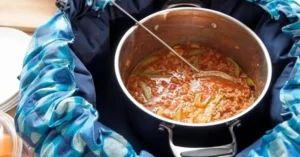
What is a Wonderbag?
A Wonderbag is a non-electric heat-retention cooker that can be used during emergencies or situations without electricity. It’s essentially an insulated bag that helps retain heat and allows for slow cooking.
The Wonderbag is an excellent cooking tool for emergencies because it requires minimal supervision and saves energy. It allows you to cook food safely without the need for a constant heat source, making it ideal for situations where electricity is unavailable.
The slow-cooking process also helps to enhance flavors and tenderize ingredients, resulting in delicious and nutritious meals.
Understanding the Wonderbag
The Wonderbag is made of an outer fabric bag filled with insulating materials such as polystyrene beads. This insulation helps to trap heat and keep the food at a high temperature for an extended period.
The concept behind the Wonderbag is heat retention cooking. It works by utilizing the initial heat source (stove or fire) to bring the food to a boil and then transferring the hot pot into the Wonderbag.
The retained heat inside the bag continues to cook the food slowly without the need for additional energy.
How to cook food with the Wonderbag
- Choose recipes suitable for slow cooking, such as stews, soups, grains, or legumes.
- Start by bringing your ingredients to a boil in a pot on a stove or fire, following the recipe instructions.
- Once the food has reached a rolling boil, turn off the heat and carefully transfer the pot to the Wonderbag.
- Place the hot pot with the food inside the Wonderbag and close the bag tightly by pulling the drawstrings or securing the Velcro flaps.
- Make sure the pot is well-insulated inside the bag, with minimal heat loss.
- Leave the pot in the Wonderbag for the recommended cooking time specified in your recipe. The Wonderbag’s insulation will keep the food hot and allow it to continue cooking slowly.
- After the recommended cooking time has elapsed, carefully remove the pot from the Wonderbag. Take precautions as the pot will still be hot.
- Check the internal temperature of the food to ensure it has reached the desired level of doneness and is safe to eat.
- Serve the cooked food immediately while it’s still hot and enjoy your meal.
With proper usage and attention to safety, the Wonderbag can be a valuable asset during emergency situations, providing you with warm and comforting meals without relying on electricity.
7. Cooking With Camping Stoves
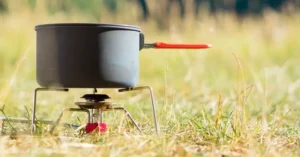
Cooking with a camping stove during an emergency when there is no electricity can be a practical and efficient way to prepare meals.
Selecting a Camping Stove
Choose a camping stove that suits your needs and emergency situation. There are several different types available, such as propane stoves, butane stoves, or multi-fuel stoves.
Consider factors like portability, fuel availability, and cooking capacity when selecting your camping stove.
Stock Up on Fuel For Your Stove
Ensure you have an adequate supply of fuel for your camping stove. Propane or butane canisters are commonly used for portable stoves and are readily available in camping, outdoor and hardware stores.
Estimate your fuel requirements based on the number of meals you anticipate cooking during the emergency period.
Bring one more canister than you think you will need, just in case.
Setting Up and Operating Your Camping Stove
Find a well-ventilated area outdoors to set up your camping stove. Make sure it is away from flammable materials, and set it on a stable, flat surface.
Preparing Meals With Your Camping Stove
Plan meals that are suitable for camping stove cooking, such as one-pot meals, quick-cooking dishes, or meals that can be easily reheated. Use cookware appropriate for the camping stove, such as lightweight pots and pans that can withstand high heat.
Prepare the ingredients in advance, chopping vegetables, marinating meat, or pre-measuring spices, to streamline the cooking process.
Camping Stove Cooking Safety
- Ensure you cook in a well-ventilated area to prevent the buildup of gases or fumes.
- Never leave the camping stove unattended while in use and keep children and pets at a safe distance.
- Use heat-resistant gloves or pot holders when handling hot cookware or adjusting the stove’s controls.
- Be mindful of fire safety and have a fire extinguisher or a bucket of water nearby for emergencies.
Cleaning Up
- Allow the camping stove to cool down completely before cleaning it.
- Remove any food residue, clean the cookware, and wipe down the stove to ensure its longevity.
Cooking with a camping stove during an emergency provides a reliable way to prepare hot meals without electricity. It’s important to familiarize yourself with the operation of the stove and practice cooking with it before an emergency arises.
With proper planning and preparation, a camping stove can be a valuable tool to sustain yourself and your family with warm and nourishing meals.
8. Cooking With Rocket Stoves
The rocket stove is a highly efficient and portable cooking device that uses small pieces of wood or biomass as fuel. It’s designed to maximize fuel combustion and heat transfer, making it an ideal option for off-grid cooking. Its vertical combustion chamber, fuel magazine, and chimney work together to create a strong, directed airflow that ensures the efficient burning of small wood pieces or biomass materials.
Quick and Efficient Cooking
Rocket stoves are designed to generate intense heat through efficient combustion. The directed airflow helps the flames reach high temperatures rapidly, reducing cooking times compared to other traditional outdoor cooking methods.
This efficiency means quicker meal preparation, which can be especially beneficial during emergency situations when resources may be limited.
Once the rocket stove is properly lit, place a heat-resistant pot or pan on the stove’s cooking surface. Opt for cookware that can withstand high heat, such as cast iron or stainless steel. Adjust the distance between the pot and the flame to regulate the cooking temperature.
Versatility in Cooking Methods
Rocket stoves can accommodate various cooking methods. You can use them for boiling, simmering, frying, or even baking. With proper adjustment of the airflow and positioning of cookware, you can achieve the desired cooking style.
From heating up water for coffee to preparing elaborate one-pot meals, the versatility of a rocket stove allows for a range of culinary possibilities.
Cooking with a rocket stove offers a practical and efficient way to prepare meals during emergencies or outdoor adventures. From quick cooking times to the ability to utilize small wood pieces as fuel, rocket stoves provide a reliable cooking solution in situations where electricity is unavailable.
With some practice and a little experimentation, you can master the art of rocket stove cooking and enjoy delicious meals even when traditional cooking methods are not available.
9. Crawfish Boil
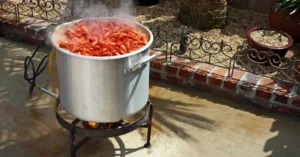
One of our personal favorites for cooking, bringing the family together, and offering comfort food during emergencies is the Crawfish Boil.
A crawfish boil, with its flavorful ingredients, holds a special place during emergencies. By adapting this beloved southern tradition to alternative cooking methods and utilizing available resources, you can create a nourishing meal that not only satisfies hunger but also strengthens bonds within your family. The crawfish boil has become a symbol of resilience, unity, and the power of coming together in the face of disaster.
For a successful crawfish boil, you’ll need several pieces of essential tools and equipment.
Large Stockpot: A sturdy and spacious stockpot is the centerpiece of a crawfish boil. It should be large enough to accommodate the desired quantity of crawfish, along with other ingredients like corn, potatoes, and sausage. Look for a pot with a strainer basket insert, which makes it easier to remove the cooked ingredients.
Propane Burner: A powerful outdoor propane burner provides the necessary heat to bring the water in the stockpot to a rolling boil. These burners are designed specifically for outdoor cooking and often come with adjustable flame controls, ensuring precise heat management.
Cajun Seasoning: Cajun seasoning is the heart and soul of a flavorful crawfish boil. It includes a blend of spices like cayenne pepper, paprika, garlic powder, onion powder, and various herbs and spices. You can purchase pre-made Cajun seasoning or create your own blend based on your preferences.
Crawfish Paddle: A crawfish paddle, also known as a Cajun stir paddle, is typically a long wooden paddle used to stir the ingredients in the boiling pot. It helps to distribute the heat evenly and prevent any sticking or burning at the bottom of the pot.
Crawfish Table: While not essential, a crawfish table adds to the authenticity and practicality of the experience. It’s a long, sturdy folding catering table covered with newspapers or butcher paper, that provides a surface for spreading out the cooked crawfish and other ingredients. The table makes it easy to gather around, peel the crawfish, and enjoy the feast.
Serving Platters, Paper Towels, and Utensils: Prepare large serving platters or trays to transfer the cooked crawfish, corn, potatoes, and sausage from the pot to the table. Tongs or slotted spoons can be used to handle and serve the hot ingredients safely. Don’t forget the paper towels, eating crawfish is a delicious but messy feast.
Embracing the Crawfish Boil Ingredients
The beauty of a crawfish boil lies in its simplicity and adaptability. The key ingredients— live crawfish (you will need about 3 to 5 pounds of crawfish per guest), onions, corn on the cob, potatoes, and sausage—are accessible and can be stored for emergencies.
Live crawfish works best, but sometimes during a power outage or after a Hurricane, your local grocery stores or seafood markets will be selling deeply discounted meats. You can pick up a few pounds of live crawfish and get a great deal, but you can also use frozen crawfish if you have it stocked.
The Cajun crawfish boil embodies the essence of southern hospitality, bringing people together for a festive culinary experience. It’s a celebration of flavorful seafood, bold spices, and the joy of communal dining.
By embracing this cherished tradition, you can create lasting memories and strengthen the bonds of friendship and family even during stressful times.
10. Non-Electric Appliances

Having non-electric appliances in your kitchen can be a game-changer. These reliable tools allow you to prepare food and maintain a sense of self-sufficiency, even when electricity is unavailable.
Manual Can Opener
A manual can opener is a simple yet indispensable tool during emergencies. Opt for a sturdy and reliable can opener that can tackle various can sizes and designs.
Keep a manual can opener in your kitchen drawer or emergency kit to ensure access to the essential contents of canned food items. Always have two can openers on hand. The prepping saying is “Two is one and one is none.”
Hand-Cranked Blender
When the power goes out, you don’t have to give up on your favorite smoothies or blended recipes! A hand-cranked blender allows you to whip up delicious drinks or purees without electricity.
With a few turns of the crank, the blender’s mechanism blends your ingredients smoothly and efficiently. Look for a durable and easy-to-use hand-cranked blender that can handle your blending needs.
Hand Mixer
Baking enthusiasts need not despair during power outages. A hand mixer, operated by manually turning the beaters, can handle tasks like whipping cream, beating eggs, or mixing batter.
Invest in a hand mixer with different speed settings and sturdy construction, allowing you to achieve desired consistency in your culinary creations.
Sometimes you can find these at your local thrift stores. They are always a great find.
Grinders and Mills
Non-electric grinders and mills are versatile tools that can be used to process grains, spices, coffee beans, and more. Hand-cranked models are available for tasks like grinding coffee or milling flour.
These appliances not only offer practicality during power outages but also allow you to enjoy the freshest flavors by grinding ingredients on demand.
Mortar and Pestle
The humble mortar and pestle is an ancient tool that continues to shine in modern kitchens, especially during power outages. Use it for grinding spices, and herbs, or even crushing garlic and ginger.
With a little manual effort, you can achieve desired textures and release the flavors of various ingredients. Plus, the mortar and pestle add a touch of tradition and craftsmanship to your culinary endeavors.
Prepping your kitchen with non-electric appliances empowers you to navigate power outages with ease and maintain a sense of self-sufficiency and comfort. You are going to need that coffee grinder.
From manual can openers and hand-cranked blenders to hand mixers and grinders, these tools provide the means to prepare meals and continue enjoying your favorite recipes.
Self-sufficiency is the key to being prepared. By embracing non-electric appliances, you can maintain a functional kitchen, enjoy home-cooked meals, and adapt to unexpected circumstances with confidence and coffee.
Conclusion of 10 Ways to Prepare Food Without Power
When faced with a power outage or emergency situation, being prepared with ingenious ways to prepare food without electricity can make a significant difference in you and your family’s comfort.
Exploring alternative cooking methods and utilizing the resources available means you can continue to enjoy your favorite meals and maintain a sense of normalcy even in a crisis situation.
From harnessing the power of open flames and grills to embracing solar cooking and utilizing non-electric appliances, there are so many great options to choose from. Each method offers its unique advantages and can be tailored to suit your family’s needs and resources.
Maintaining a well-stocked emergency pantry is crucial for your preparedness. Stock up on essential food supplies that your family enjoys and that require little to no cooking, such as canned goods, dried fruits, and nuts. These items can provide additional nutrition when your cooking options are limited.
Consider including long-lasting and non-perishable items like rice, beans, pasta, and canned protein sources. These staples serve as a foundation for creating simple and satisfying meals.
Additionally, don’t forget about the power of community and the importance of coming together during challenging times. Share resources, collaborate with neighbors, and support one another in preparing and cooking meals. A shared meal can bring comfort, foster a sense of togetherness, and boost morale during difficult circumstances.
By staying informed, planning ahead, and implementing these ways to prepare food without power, you can navigate emergencies with greater resilience and confidence. Remember to prioritize safety and practice using your cooking method before a power outage.
So, whether you’re grilling over an open flame, harnessing the energy of the sun, or getting creative with non-electric appliances, let your ingenuity and resourcefulness shine through.
With these innovative approaches, you can continue to enjoy nourishing meals, maintain your self-sufficiency, and find solace in the comfort of a well-prepared and delicious meal, even when the power is out.
Have comments, suggestions, or more to add to the conversation? Join us on Facebook to share your thoughts about cooking and preparing food without power. Connect with a community of preppers in the South who are passionate about staying safe and prepared. Let’s come together, share insights, and support one another on our preparedness journey—join us today at Southern Prepper.
Our Top 10 Preps and Supplies To Pepare Food Without Power
- Camp Chef Explorer Double Burner Stove: A powerful outdoor stove with two burners for versatile cooking options.
- Lodge 15″ Pre-Seasoned Cast Iron Skillet: A durable and versatile skillet that can be used over an open fire or on a camp stove.
- Lodge 8 Quart Dutch Oven: A heavy-duty cast iron Dutch oven with legs and a lid for cooking over a campfire or charcoal.
- GSI Outdoors Halulite Kettle: A lightweight and durable kettle for boiling water or preparing hot beverages.
- Snow Peak Titanium Cookware Set: Lightweight and durable titanium cookware set for outdoor cooking.
- Wire Mosse Rocket Stove: An efficient and environmentally friendly stove that uses small branches or twigs as fuel.
- Texsport Heavy-Duty Over Fire Camp Grill: A sturdy and adjustable grill grate that can be placed over an open fire for direct cooking.
- Bayou Classic Stainless Steel Boiler: Ideal for outdoor cooking and community gatherings, this 82-quart boiler feeds a crowd.
- Swing-A-Way Easy Crank Can Opener: This can opener is one you can rely on to get through tough can tops effortlessly.
- Sunflair Portable Solar Oven: Harness the power of the sun to cook food efficiently and sustainably.


